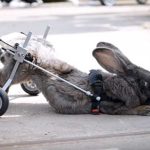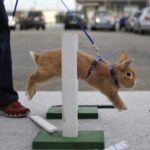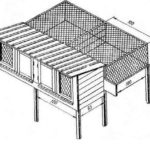A common pathological condition in rabbits is paralysis of the paws, with the hind limbs most often failing. When a rabbit's hind legs fail, there may be several reasons for this: injuries, dysfunction of the nervous system, infectious pathologies, malfunction of the digestive tract, calcium deficiency. If a rabbit is raised for meat, then it is easier to slaughter it; if the pet is decorative, then treatment is chosen taking into account the cause of paralysis.
Possible causes and necessary actions for paralysis of the hind limbs
To properly treat a rabbit, you first need to understand what caused the paralysis of the hind legs. The owner must remove the sick animal from the livestock and place it in a small cage that limits body movements that could cause the condition to worsen. Next, you need to check whether there are any broken limbs or other injuries to the body. If a fracture is detected, the injured paw should be secured with a splint.
A sick rabbit should be taken to a veterinary clinic in a well-ventilated carrier. Only a veterinarian can prescribe treatment.
Lack of calcium in the body
If a rabbit eats food containing little calcium, then its body uses up the mineral accumulated in bone tissue. The skeleton becomes weak and cannot support muscle mass. Most often, calcium deficiency is observed in rabbits during the lactation period. The female gives a significant part of the calcium to the cubs in her milk, which negatively affects the condition of her skeleton. Mineral deficiency also occurs in milk-fed rabbits, if the mother does not produce enough milk, or if the mother rabbit feeds her offspring irregularly.
The first thing you need to do to normalize the calcium content in a rabbit’s body is to change the diet. You need to add calcium-rich foods to it:
- crushed eggshells;
- bone meal;
- chalk.
Additionally, calcium supplements are given:
- gluconate (as a dietary supplement);
- glutamate (as a supplement);
- borogluconate (in the form of subcutaneous and intramuscular injections);
- gamavit.
Constipation or diarrhea
Disruption of the digestive tract, leading to failure of the rabbit's hind legs, occurs due to poisoning with low-quality concentrated feed or poisonous plants. Most often, poisoning, accompanied by failure of the hind limbs, occurs after the animal eats fresh grass, which the owner forgot to wither. Some farmers try to prepare a lot of grass at once, heaping it in a heap, but they do not know that when left in it for a long time, beneficial compounds turn into poisonous ones.
The main sign that paralysis of the hind legs is caused by poisoning is the mass destruction of animals. Almost all livestock that have consumed poisonous food become ill.
To eliminate the disease, rabbits are provided with a high-quality diet. It includes mixed feed with clover and alfalfa to prevent mineral and vitamin deficiency. Fresh grass is given after it has been dried.
Brain inflammation
In rabbits, the hind limbs are often taken away due to infectious pathologies that cause inflammation of the brain:
- encephalitis;
- meningitis;
- encephalomyelitis;
- encephalozoonosis.
Infectious diseases, in addition to paralysis of the hind legs, are accompanied by distortion of movements, curvature of the neck, and the animal falling on its side.
The listed pathologies are dangerous; inflammation of the brain causes the rapid death of the animal. Therefore, a sick rabbit is immediately shown to a veterinarian. He prescribes antibiotics, anti-inflammatory medications and immunostimulants.
Listeriosis
A dangerous pathology, due to which a pregnant rabbit’s legs fail, is caused by the microscopic parasite Listeria. The cubs die in the womb, but miscarriage does not always happen, sometimes it is partial.The embryos remaining in the uterus decompose, provoking an inflammatory process that spreads to the hind legs.
A sick rabbit is slaughtered. Treatment is possible, but is not used on farms, since the surviving animal becomes a carrier of the infection. In this case, the livestock is replaced, and the rabbitry is thoroughly disinfected. Before new rabbits are introduced, they are quarantined for 2 weeks. The fur of dead animals is burned. Meat can be consumed, but after 2 hours of cooking. If an ornamental pet gets sick, the veterinarian will prescribe antibiotics and procedures to restore sensitivity in the hind limbs.
Injuries
Rabbits' legs often suffer from injury caused by falls, fights, or unsuccessful movements inside a cramped cage. Paralysis of the hind legs occurs as a result of damage to either the spinal column or the brain.
In the first case, the transmission of impulses along the spinal nerves to the limbs is interrupted. There is no way to fix this. The pet will remain crippled. In the second case, the transmission of signals from the areas of the brain responsible for motor activity is interrupted. The rabbit not only loses his legs, but also loses his coordination.
If a rabbit has only one leg that is motionless, then most likely it only has a fracture. X-ray examination is required to confirm the diagnosis. For paralysis of the hind legs caused by damage to the spine or brain, the veterinarian prescribes anti-inflammatory medications, analgesics, and physiotherapeutic procedures. The owner will have to give the rabbit a massage and purchase a wheelchair for the animals.
CNS dysfunction
Impaired functioning of the nervous system becomes a consequence of stress, severe fear, and as a result, the rabbit’s hind limbs fail.
Rabbits are extremely shy animals.They can be paralyzed by:
- transportation;
- noisy renovation work;
- sudden switching on of intense light;
- the approach of another pet;
- painful veterinary procedures;
- lifting by the ears or scruff.
If the functioning of the nervous system is disrupted, the veterinarian will prescribe a massage to restore muscles. It is not difficult to carry out: you need to hold the animal on its back with one hand, and with the other, bend and straighten one and the other hind paw with smooth movements.
Decorative pets often undergo acupuncture and hardware procedures to restore numb muscles.
Other Possible Causes
Less commonly, a rabbit’s legs fail for the following reasons:
- Pododermatitis is ulceration and injury to the soles of the feet due to unsanitary conditions or thin bedding on a slatted floor.
- Deficiency of B-group vitamins provokes nervous pathologies, accompanied by impaired transmission of impulses to the hind limbs.
- Oxygen deficiency as a result of pulmonary pathologies leads to impaired blood supply to the hind legs, causing the muscles to weaken.
- Toxins released into the blood during coccidiosis, pasteurellosis, and other severe infectious diseases cause disruption of brain function and weakening of muscles.
Preventive actions
To prevent paralysis of the hind limbs in rabbits, measures are taken to prevent infection and create optimal living conditions in the rabbitry.
Necessary preventive measures:
- Keeping purchased rabbits in quarantine for 2 weeks.
- Regular cleaning and disinfection of the rabbitry. Extermination of rats and mice carrying the infection.
- Vaccination of pets against listeriosis in a region with an unfavorable epidemic situation.
- Purchasing quality food. Balanced diet, including dry concentrates. Reducing portions of root vegetables.
- Disposal of last year's hay residue. Procurement of compound feed, grass and grain food for a short period.
- Supplementing the diet with legumes containing high concentrations of protein and minerals.
- Timely removal of manure.
- Careful handling of rabbits during transportation and relocation.
- Arrangement of cages so that animals cannot be injured.
Can a rabbit live with paralysis?
Survival depends on the cause of hind limb failure and the endurance of the body. A weak animal with an infectious lesion dies after a few days; a strong, injured rabbit can live as an invalid for several years. Often, with a minor pathology and quality care, the animal recovers and returns to a full life.






















